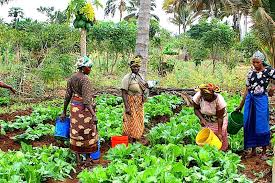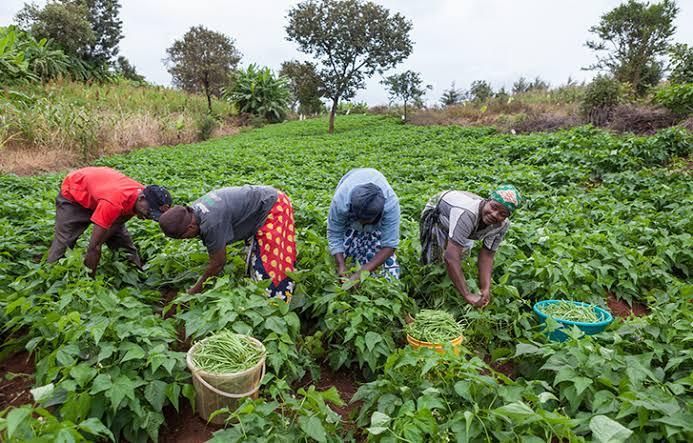In 2017, over 72 metric tonnes of yams that arrived in the United States from Nigeria came rotten. The yams left the Lagos port in July and arrived in the US after passing through 12 ports, in September…a glimpse of the failing system of agriculture in Nigeria.
By Sybil Fekurumoh
Once upon a time, agriculture was the major source of foreign exchange earnings to Nigeria through its export of cash crops. Between the 50s and 60s, exporting groundnut made up for 70% of the country’s export revenue. The groundnut pyramids of Kano were infamous not just as a wealth symbol to farmers, but as an aggregation point before shipment for export. The pyramids were, at the time, a tourist attraction. Between 1961 and 1965, Nigeria accounted for 43% of the global oil palm production. But exports dwindled when crude oil was discovered in the south, and agriculture was subsequently tossed away like an old toy. Malaysia improved on West African oil palm variety, and has now displaced Nigeria to be the second highest producers of oil palm.
To solve youth unemployment and the innumerable economic challenges that Nigeria faces, the present administration proposes agriculture as a supposedly finite solution. Nigeria’s President, H.E. Muhammadu Buhari, in an interview with Channels TV, commented that the perplexity to the country’s plummeting economic crisis was that not enough people engaged in farming. He said, “…but all I know is that we have to allow people have access to the farm. We just have to go back to the land.”
To encourage the country’s domestic agriculture industry, the administration also in 2015 put an embargo on the importation of foodstuffs, particularly banning the import of rice into the country. This only resulted to a drastic and continuous increase in food prices.
The President’s assertion that more people need to engage in agriculture is inapt as over 70% of Nigerians already engage in agriculture, however, at a subsistent level, contributing about 30% to the country’s gross domestic product.
But the problem isn’t that fewer number of people engage in agriculture in Nigeria; it is that the system is not commercialised. In the US, less than 2% of the workforce engage in large-scale agriculture, yet, the US is among the largest exporters of agricultural products.
The Nigerian government introduced the Anchor Borrowers’ Programme in 2015 to provide farmers with loans that would supposedly help boost agricultural production, stabilise input supply to agro-processors, and address the country’s negative balance of payments on food. As remarkable as this intervention sounded, only 3.8 million of farmers benefitted from the scheme, which is less than 5% of the farmers that actually need funding. Other interventions like the NIRSAL Agro Geo-Cooperative Loan, and the Commercial Agricultural Credit Scheme (CACS) have also been introduced by the CBN.

As stated, the majority of agricultural practices revolves around subsistent agriculture, which, by elementary definition, involves small scale production that is insufficient for exportation. So even when large number of persons are farming, the production may still not be enough to make the country self-sufficient. Take rice for example; Nigeria is its highest producer in Africa, yet, the country has one of the largest markets for imported parboiled rice from Thailand and China. The reality is that the production cost of rice is high, which limits its large-scale production.
The Dangote tomatoes processing factory in Kano faces intermittent shut-downs because the factory is unable to process adequate quantity of tomatoes to keep the place operational, making the country to run at losses.
The government needs to address the challenges to food security rather than asking for more people to venture into agriculture. This can be done by fully industrialising the system by offering financing, incorporating technology, providing better infrastructure and restructuring the entire value chain. What innovative means are being used to foster the agricultural system in Nigeria?
Nigeria is still heavily reliant on rainfall for cultivation. As at 2018, only 1% of Nigerian farmlands are irrigated. This system is not sustainable, as the effect of climate change has resulted in detrimental losses to farmers. Increase in temperatures has caused a higher rise in sea levels, flooding, droughts, and many other forms of land degradation. The south-south region now experiences annual flooding that halts all agricultural activities till the water recedes. One of the causes of the poorly addressed farmer-herder crisis that has become grossly prevalent in Nigeria is drought, which causes herders to migrate to humid regions for pasture.
Asides increased cost of production suffered by farmers from diseases, pests, etc., another challenge is the transportation and storage of these perishable produce. About 25% of produce are lost postharvest due to spoilage caused by improper storage. The shell-life is reduced, in turn reducing the price of the product. Bad road networks across the country also makes movement from farms to market difficult.

Assuming, against these odds, that produce are substantial enough to be exported, another challenge arises. In 2017, over 72 metric tonnes of yams that arrived in the United States from Nigeria came rotten. The yams left the Lagos port in July and arrived in the US after passing through 12 ports, in September. The port did not have the right facilities to store the yams for export, and they spent three months in transit, too long a time for produce not properly stored.
Nigeria ranks at about 70% in yam production, making the country the highest producers of yams in West Africa. Nigerian yam is also arguably better in terms of quality and taste. Yet, Ghana is the highest exporter of yam, accounting for 94% of all yam exports in West Africa. Some even suggest that most of the yams exported by Ghana are gotten through Nigeria. Ghana, unlike Nigeria, has been able to provide the right facilities to aid its export. Out of the six ports in Nigeria, only the ports in Lagos are relatively functional.
Generally, agriculture is a risk-taking, resource-consuming venture as the process from planting, raising, rearing, to when the produce reaches the final consumer, is a delicate, time-taking process. What the Nigerian agricultural sector needs are resources that would effectively ease production process; better road access to farms and ports, improvement on seeds, an improvement on local livestock, and better policies that make for adapting and incorporating tech into agriculture. Of the fundings provided to scale tech startups in Nigeria, Agrictech companies attracted only a meagre 0.3%. Nigeria’s population is increasing exponentially, the country must device innovative ways to address food security.
Sybil Fekurumoh is a freelance writer from Bayelsa. Connect with her via Twitter and Instagram @toqueensaber or shoot her a mail at sybilfekurumoh@gmail.com




